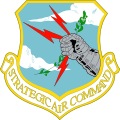| Space Operations Command | |
|---|---|
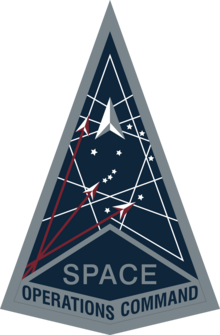 Space Operations Command emblem Space Operations Command emblem | |
| Founded | 21 October 2020; 4 years, 2 months as Space Operations Command 1 September 1982; 42 years, 4 months as Air Force Space Command |
| Country | |
| Branch | |
| Type | Field command |
| Role | |
| Size | 11,000 personnel |
| Headquarters | Peterson Space Force Base, Colorado, U.S. |
| Motto(s) |
|
| Colors | Platinum |
| Engagements | Global War on Terrorism |
| Decorations | Air Force Organization Excellence Award |
| Website | www www |
| Commanders | |
| Commander | |
| Vice Commander and DCG (Operations) | |
| DCG (Support) | Brian T. Kehl |
| DCG (Transformation) | BGen. Kyle C. Paul, RCAF |
| Senior Enlisted Leader | CMSgt Caleb M. Lloyd |
| Insignia | |
| Flag |  |
| Space Operations Command subdued emblem | 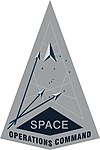 |
Space Operations Command (SpOC) is the United States Space Force's space operations, cyber operations, and intelligence field command. Headquartered at Peterson Space Force Base, Colorado, it consists of its mission deltas, and garrison commands.
It was established on 1 September 1982 as Space Command (SPACECOM), the first dedicated space command in the United States Armed Forces. On 15 November 1985, it was renamed Air Force Space Command (AFSPC or AFSPACECOM) to distinguish it from U.S. Space Command, Naval Space Command, and Army Space Command. On 20 December 2019, following the establishment of the United States Space Force as an independent service, Air Force Space Command was also redesignated as United States Space Force (USSF) and served as the transitional headquarters of the new service, but remained a component of the U.S. Air Force. On 21 October 2020, United States Space Force was redesignated as Space Operations Command and officially transitioned from a U.S. Air Force major command to a U.S. Space Force field command.
History
Establishing Space Command
Air Force major commands responsible for space operations
The Air Force's space program began in 1954 with the establishment of the Western Development Division under Brigadier General Bernard Schriever. However, its space operations were fragmented across several different Air Force major commands. Aerospace Defense Command was responsible for space surveillance and missile warning, Strategic Air Command operated weather satellites, and Air Force Systems Command, primarily responsible for research and development, also had operational responsibilities for operating communication satellites and space launch.
As Air Force space programs began to mature in the 1970s and early 1980s, their disjointed nature presented operational issues. The impending deployment of the Space Shuttle in partnership with NASA prompted major internal competition between the Air Force's major commands for internal control and to transform itself into an operational major command. Air Force Systems Command's Space and Missile Systems Organization had responsibility for military development of the shuttle, but it also sought operational responsibility as it was responsible for space launches. Aerospace Defense Command argued that its responsibility for the space surveillance system gave it the requisite experience required for shuttle operations. Traditional air defense had also lost its importance, and Aerospace Defense Command saw space operations as a means to preserve its existence. Strategic Air Command and Military Airlift Command, which served as the Air Force's lead on transportation, also argued they should have responsibility. In 1980, Aerospace Defense Command was inactivated as an Air Force major command (although preserved as a specified command within NORAD), with its air defense mission transferred to Tactical Air Command in 1979 and its space assets moved to Strategic Air Command in 1980.
Calls for an independent space command grew within the 1980s, with some in Congress even calling for the Air Force to be reorganized as the U.S. Aerospace Force. On 1 September 1982, the Air Force established Space Command as a major command, creating the first operational space command within the United States Armed Forces.
Unifying Space Forces under Air Force Space Command
Space divisions, wings, and groups-
 9th Space Division
9th Space Division
-
 Space Communications Division
Space Communications Division
-
 1st Space Wing
1st Space Wing
-
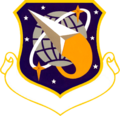 2d Space Wing
2d Space Wing
-
 3d Space Support Wing
3d Space Support Wing
-
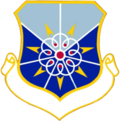 73d Space Group
73d Space Group
When Space Command was established, it was headquartered at Peterson Air Force Base, Colorado and consisted of the Aerospace Defense Center and Cheyenne Mountain Support Group. In 1983, Strategic Air Command began to transfer its space and missile warning, systems, bases, and units to Space Command, establishing the 1st Space Wing on 1 January 1983. Major transfers from Strategic Air Command included Peterson Air Force Base, Thule Air Base, Sondrestrom Air Base, Clear Air Force Station, and responsibility for the creation of Falcon Air Force Station. By 1984, Strategic Air Command ceased to be responsible for space operations, transferring the Defense Meteorological Satellite Program and Defense Support Program, as well as operational responsibility for the Military Strategic and Tactical Relay and Global Positioning System, both of which were in development. In 1985, Space Command activated the 2d Space Wing and renamed to Air Force Space Command on 15 November, to distinguish itself from Naval Space Command and the new United States Space Command. In 1986, Air Force Space Command established the 3rd Space Support Wing and inactivated the Aerospace Defense Center and Cheyenne Mountain Support Group. In 1989, the 73d Space Surveillance Group was activated under Air Force Space Command, centralizing its space surveillance capabilities.
Unlike Strategic Air Command, Air Force Systems Command was reluctant to transfer over its space assets. The Air Force Satellite Control Network was not reassigned to Air Force Space Command until 1987. The Combined Space Operations Center would not be fully transferred over until 1993 Space launch would remain under Air Force Systems Command until 1990, when Air Force Space Command began a gradual takeover. While Air Force Space Command had sought the mission since its activation, Air Force Systems Command had fought the change at every turn. Delta II and Atlas E launches transferred first, followed by the Atlas II, Titan II, and Titan IV. On 1 October 1990, Air Force Systems Command transferred Patrick Air Force Base, Cape Canaveral Air Force Station, and Vandenberg Air Force Base to Air Force Space Command. On the same day, the 9th Space Division and Space Communications Division were activated to manage launch functions.
The Gulf War, Space Commission, and Global War on Terrorism
Space air forces, centers, and wings-
 Fourteenth Air Force
Fourteenth Air Force
-
 Space and Missile Systems Center
Space and Missile Systems Center
-
 Space Innovation and Development Center
Space Innovation and Development Center
-
 614th Air and Space Operations Center
614th Air and Space Operations Center
-
 21st Space Wing
21st Space Wing
-
 30th Space Wing
30th Space Wing
-
 45th Space Wing
45th Space Wing
-
 50th Space Wing
50th Space Wing
-
 310th Space Wing (Reserve)
310th Space Wing (Reserve)
-
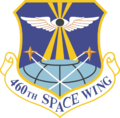 460th Space Wing
460th Space Wing

Air Force Space Command provided significant support to coalition forces during the Gulf War, providing communications and navigation through the Defense Satellite Communications System and Global Positioning System. Missile warning against SCUDs was provided by the Defense Support Program and weather forecasting through the Defense Meteorological Support Program. Space forces proved so decisive that the Gulf War was coined the "first space war" by General Merrill McPeak and its status was elevated within the Air Force.
In 1991, Air Force Space Command underwent a major reorganization, inactivating the 9th Space Division and Space Communications Division and replacing it with the 30th Space Wing at Vandenberg AFB and 45th Space Wing at Patrick AFB for space launches. In 1992, it replaced the 1st Space Wing with the 21st Space Wing, the 2d Space Wing with the 50th Space Wing, and inactivated the 3d Space Support Group. In 1993, Air Force Space Command was assigned responsibility for intercontinental ballistic missiles. It centralized its space forces under the Fourteenth Air Force and its missile forces under the 20th Air Force, while also activating the Space Warfare Center. In 2001, following the recommendation of the Space Commission, the Space and Missile Systems Center was transferred from Air Force Materiel Command to Air Force Space Command, unifying space acquisitions and operations under the same command. This gave Air Force Space Command a unique status among the other Air Force major commands, as it was the only one to be responsible for its own acquisition. Following the September 11 attacks, Air Force Space Command provided space support to the Global War on Terrorism.
In 2009, the Air Force decided to consolidate its nuclear forces, split between Air Force Space Command's Twentieth Air Force missiles and Air Combat Command's Eighth Air Force bombers, under Air Force Global Strike Command. Twentieth Air Force was transferred on 1 December 2009, however Air Force Space Command had been assigned the cyberspace mission in the same year, assuming responsibility for Twenty-Fourth Air Force, the Air Force Network Integration Center, and Air Force Spectrum Management Office. In 2013, the Space Innovation and Development Center (previously the Space Warfare Center) was inactivated and merged with the Air Force Warfare Center. In 2018, the cyber mission and Twenty-Fourth Air Force were transferred to Air Combat Command leaving Air Force Space Command with sole responsibility for space forces.
Missile air forces, wings, and groups (1993–2009)-
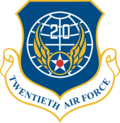 Twentieth Air Force
Twentieth Air Force
-
44th Missile Wing
-
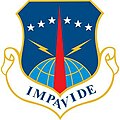 90th Space Wing
90th Space Wing
-
 91st Space Wing
91st Space Wing
-
 341st Space Wing
341st Space Wing
-
351st Missile Wing
-
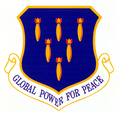 321st Missile Group
321st Missile Group
-
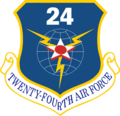 Twenty-Fourth Air Force
Twenty-Fourth Air Force
-
 Air Force Network Integration Center
Air Force Network Integration Center
-
 Air Force Spectrum Management Office
Air Force Spectrum Management Office
-
 624th Operations Center
624th Operations Center
-
 67th Cyberspace Wing
67th Cyberspace Wing
-
 688th Cyberspace Wing
688th Cyberspace Wing
-
 689th Combat Communications Wing
689th Combat Communications Wing
Redesignation as Space Operations Command and transfer to the Space Force

When the United States Space Force was established as an independent service on 20 December 2019, Air Force Space Command was redesignated as United States Space Force and served as its interim headquarters, but remained part of the U.S. Air Force. Fourteenth Air Force was redesignated as Space Operations Command, however its wings, along with the Space and Missile Systems Center's 61st Air Base Group, were realigned to report directly to United States Space Force. In June 2020, the Space Force announced its plan to establish Space Operations Command as the first of three field command, with Space Operations Command (formerly Fourteenth Air Force) at Vandenberg AFB to be renamed SpOC West.
In July 2020, United States Space Force's wings and operations groups were renamed deltas and it assumed responsibility for space operations units previously part of Air Combat Command and Air Education and Training Command, including the 544th Intelligence, Surveillance and Reconnaissance Group. The 21st Operations Group was replaced by Space Delta 2 for space domain awareness, the 721st Operations Group was replaced by Space Delta 3 for space electromagnetic warfare, the 460th Operations Group combined with elements of the 21st Operations Group to form Space Delta 4 for missile warning, the 614th Air Operations Center became Space Delta 5 for command and control, the 50th Network Operations Group became Space Delta 6 for cyberspace operations, the 544th Intelligence, Surveillance and Reconnaissance Group became Space Delta 6 for intelligence, surveillance and reconnaissance, the 50th Operations Group became Space Delta 8 for navigation warfare and satellite communications, and the 750th Operations Group became Space Delta 9 for orbital warfare. The 21st Space Wing and 50th Space Wing was replaced by Peterson-Schriever Garrison, which oversaw Peterson Air Force Base, Schriever Air Force Base, Cheyenne Mountain Air Force Station, Pituffik Space Base, New Boston Air Force Station, and Kaena Point Satellite Tracking Station, while the 460th Space Wing was replaced by Buckley Garrison, which oversaw Buckley Air Force Base, Cape Cod Air Force Station, Cavalier Air Force Station, and Clear Air Force Station. The 25th Space Range Squadron, 328th Weapons Squadron, 527th Aggressor Squadron, and 533rd Training Squadron were incorporated into Space Training and Readiness Delta (Provisional), pending the activation of Space Training and Readiness Command as a full field command.
On 21 October 2020, United States Space Force was redesignated as Space Operations Command, officially transferring from a U.S. Air Force major command to a U.S. Space Force field command when Lieutenant General Stephen N. Whiting assumed command. In 2021, SpOC restructured its headquarters staff by dividing it into three deputy commanding general (DCG) positions, a deputy commanding general each for operations, support, and transformation. It also organized oversight of Space Deltas 2 to 9 under the deputy commanding general (operations) by creating five mission area teams (MAT): intelligence, battle management C3, componency, combat power, and information mobility.
On 22 April 2021, the Space and Missile Systems Center was realigned from Space Operations Command to the U.S. Space Force. In May 2021, the 30th Space Wing was redesignated as Space Launch Delta 30 and the 45th Space Wing redesignated as Space Launch Delta 45. On 13 August 2021, it transferred its launch deltas to Space Systems Command as it activated and on 23 August 2021 Space Training and Readiness Delta (Provisional) was inactivated and its squadrons transferred to Space Training and Readiness Command.
Symbolism
Emblems of Space Operations Command and its predecessors-
 Space Operations Command (2020–present)
Space Operations Command (2020–present)
-
 United States Space Force (2020)
United States Space Force (2020)
-
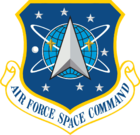 Air Force Space Command and Space Command (1982–2019)
Air Force Space Command and Space Command (1982–2019)
Space Operations Command emblem and color
The large delta in the Space Operations Command emblem is derived from the legacy Air Force Space Command emblem, which also is found in the Seal of the United States Space Force. It represents the people of the U.S. Space Force and the advanced systems Space Operations Command operates. The three smaller deltas, which take the shape of arrows when combined with the rocket trails behind them, are taken from the U.S. Space Command seal, represent Space Operations Command's combatant command mission and the role of its deltas, garrisons, and SpOC West to be the arrows in U.S. Space Command's warfighting quiver. They also represent Space Operations Command's core competencies of operations, military intelligence, and cyber. The star field is the constellation Orion, representing the mythological Greek hunter Orion. Orion signifies that Space Operations Command will always be the predator, and never the prey. The stars that make up the constellation also pay respect to the past luminaries and leaders of military space who have built the foundation on which Space Operations Command stands.
Platinum is Space Operations Command's distinguishing color and matches the U.S. Space Force and U.S. Space Command seals. Platinum represents the strength of Guardians and Airmen, the rarity of its calling, and the nobility of its mission.
Space Operations Command's emblem was unveiled on 21 October 2020 at Peterson Air Force Base, Colorado with the resignation of United States Space Force, previously Air Force Space Command, as Space Operations Command.
Air Force Space Command emblem and motto

The first commander of Air Force Space Command, General James V. Hartinger, suggested that the Air Force Space Command emblem be patterned after the Space Badge and the final emblem drew on it for most of its elements.
The centrally dominant globe represents the earth as viewed from space, the earth being both the origin and control point for all space satellites. The lines of latitude and longitude emphasize the global nature of Air Force space operations. The emblem is provided its distinctive appearance by two symmetric ellipses representing the orbital paths traced by satellites in earth orbit; the satellites themselves being symbolically depicted as four point stars. The 30 degree orbital inclination and symmetrically opposed placement of the satellites signify the worldwide coverage provided by Air Force satellites in accomplishing the surveillance and communications missions. The slight tapering of the orbital ellipses represents the characteristic eastward motion. The centrally superimposed deltoid symbolizes both the Air Force upward thrust into space and the launch vehicles needed to place all satellites in orbit. The distinctive dark blue background shading, small globe, and stars symbolize the space environment.
Air Force Space Command's motto, "Guardians of the High Frontier," was developed from the submissions of three individuals at Space Command and the United States Air Force Academy before being announced on 17 February 1983. The motto would later inspire the title of "Guardian" for U.S. Space Force members.
Structure
List of commanders
Main article: Commander of Space Operations Command
| No. | Portrait | Name | Term | ||
|---|---|---|---|---|---|
| Took office | Left office | Duration | |||
| 1 |
 | Lieutenant General Stephen Whiting (born 1967) | 21 October 2020 | 9 January 2024 | 3 years, 80 days |
| 2 |
 | Lieutenant General David N. Miller (born c. 1971) | 9 January 2024 | Incumbent | 363 days |
See also
U.S. Armed Forces forces commands
- United States Army Forces Command
- United States Marine Corps Forces Command
- United States Fleet Forces Command
- Air Combat Command
References
- ^ "Space Operations Command (USSF) Lineage". Retrieved 31 January 2022.
- "About Space Operations Command". www.spoc.spaceforce.mil.
- "Space Force's operational commander describes history of space as a contested domain". Space Operations Command (SpOC).
- "Space Operations Command Motto Reveal: Via Vincimus". DVIDS.
- ^ "Space Operations Command Emblem Reveal".
- ^ "Space Operations Command (USSF)".
- "Dr. Brian T. Kehl". www.spoc.spaceforce.mil.
- "BGen Kyle C. Paul". Space Operations Command. 16 June 2022.
- "CHIEF MASTER SERGEANT CALEB M. LLOYD". Space Operations Command. 7 August 2023.
 This article incorporates text from this source, which is in the public domain.
This article incorporates text from this source, which is in the public domain.
- "About Space Operations Command".
- "About Space Operations Command". www.spoc.spaceforce.mil. U.S. Space Force. Archived from the original on 25 May 2023.
- ^ Spires, David N. "Beyond Horizons - A Half Century of Air Force Space Leadership" (PDF). Archived from the original (PDF) on 13 June 2019.
- "GPS and the World's First "Space War"". Scientific American.
- ^ "AFSPC History". www.afspc.af.mil.
- Chiles, Cody (27 December 2019). "14th Air Force Redesignated as Space Operations Command". Space Operations Command. Retrieved 1 January 2020.
- "SpOC Fact Sheet". Space Operations Command. Retrieved 22 October 2020.
These initial actions provided immediate structure for the USSF but were not intended to reflect the end-state of the new branch of Service.
- Kirby, Lynn (30 June 2020). "USSF field command structure reduces command layers, focuses on space warfighter needs". United States Space Force. Retrieved 22 October 2020.
The staff and operations elements of USSF at Peterson Air Force Base, Colorado, which is also the former AFSPC, will become the headquarters SpOC. There is an existing unit at Vandenberg AFB, California, named Space Operations Command, which will be renamed upon activation of the field command SpOC.
- United States Space Force, Public Affairs (24 June 2020). "Space Force begins transition into field organizational structure". United States Space Force. Retrieved 3 February 2021.
- "SpOC ReEngineering Explainer". DVIDS.
- "Vandenberg AFB gets new U.S. Space Force name".
- "USSF establishes 2nd Field Command, Guetlein assumes command". United States Space Force. 13 August 2021.
- "Space Force activates Space Training and Readiness Command". United States Space Force. 23 August 2021.
- ^ "Air Force Space Command (Archived) > About Us > AFSPC History > afspcemblem". www.afspc.af.mil.
- "U.S. Space Force unveils name of space professionals".
- "Col. Raj Agrawal assumes command of Delta 2". Space Operations Command (SpOC). 23 June 2023. Retrieved 3 September 2023.
External links
| Subordinate organizations |  | |
|---|---|---|
| Service component commands |
| |
| Former service component commands | ||
| Air Forces |  | ||||||||||||
|---|---|---|---|---|---|---|---|---|---|---|---|---|---|
| Centers | |||||||||||||
| Bases | |||||||||||||
| Stations | |||||||||||||
| Space wings | |||||||||||||
| Air Base groups |
| ||||||||||||
| Squadrons |
| ||||||||||||
- Field commands of the United States Space Force
- Military globalization
- Military units and formations established in 1982
- Military units and formations established in 2020
- 1982 establishments in the United States
- Space warfare
- Military units and formations in Colorado
- Organizations based in Colorado Springs, Colorado
- Satellite operators
- United States nuclear command and control


